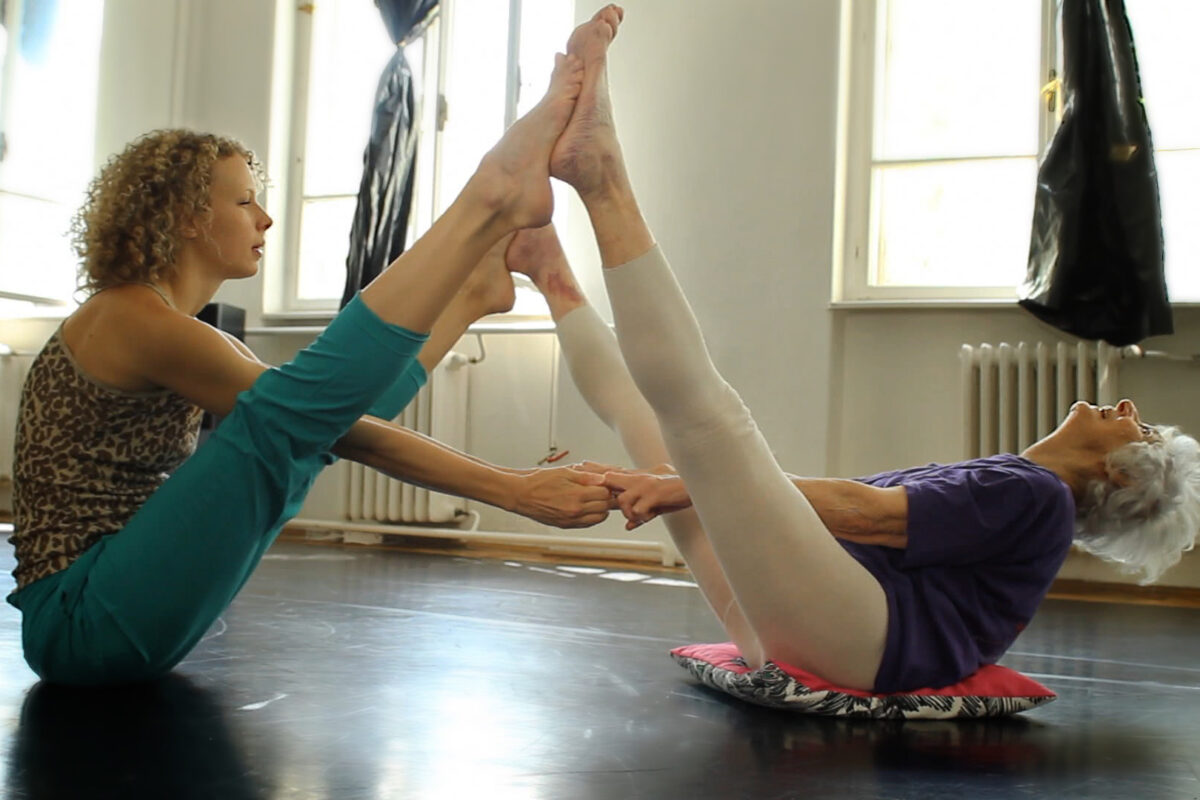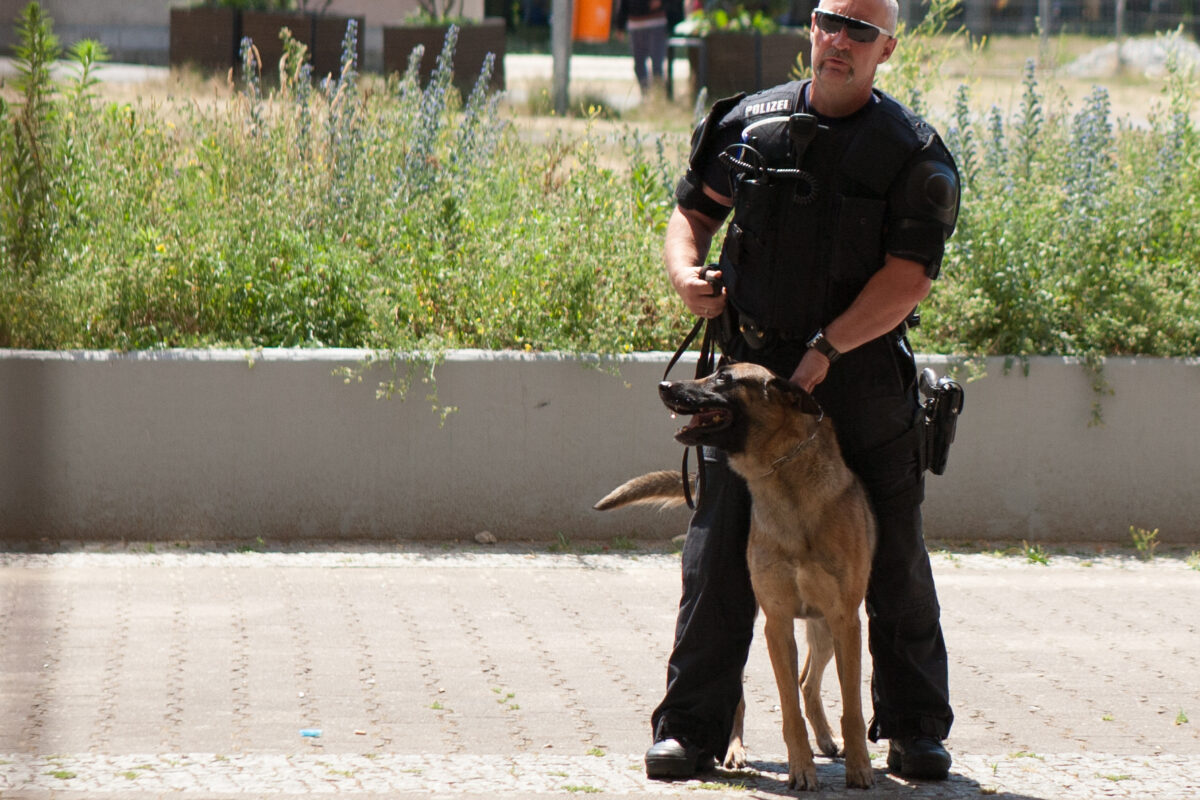Close to the start of the film we view the laying of some Stolpersteine – the metal squares embedded into the street which commemorate Holocaust victims. They’re all over Berlin (and rightly so, Never Forget), but I presume these are in Hungary. They’re commemorating the family of Éva Fahidi. We watch her telling a reporter that 49 of her family members died in the Holocaust.
The film then goes back 10 months to a letter Éva received from the choreographer Réka Szabó. Szabó wanted to make a dance show “Strandflieder” (sea lavender) about Éva’s history, starring a young dancer, Emese Cuhorka, who looks like the young Éva. Éva herself is also to perform. This would require months of rehearsal, and the premiere will be around Éva’s 90th birthday. She agrees without question.
Now, of all the art forms, dance is the one with which I’ve had the most difficulties. I can appreciate the dancers’ impressive control of their bodies, just as one can appreciate the performance of gymnasts. But when a dance piece is supposed to be about something – the form is just too abstract for my brain to be able to make that leap.
Szabó’s piece helps people like me by including readings of Éva’s reminiscences of her experience in Auschwitz. These readings are both moving and heart-breaking. There’s an old cliché about art taking your breath away, but at times listening to Éva I really did have trouble breathing.
“The Hungarian authorities deported us in such a tempo, that there wasn’t time for anything. The barracks in which were were supposed to be housed were not finished. Nothing was finished. And more and more people came. And the worst of this hectic was that the gas chambers could have killed everyone, they had the capacity for that, but the four crematoria which were working day and night could not burn everyone. So the corpses were burned in an open fire. Can you imagine the stench?”
To say that Éva is more agile than most people half her age is to make a great understatement. In her youth she danced – but never professionally and she never had lessons. But she has all the moves and is both energetic and spritely. And yet, her body is not what it used to be. In a later scene we see her struggling to open the door of the theatre in which she’s about to perform.
“I sleep in the dust among a thousand other people. Wrapped in my father’s dressing gown. Cattle trucks were rolled in the brickyard. There is no air in the trucks. There is no water. There are no toilets. My uncle Tóni, who the Gendarmes beat up at the last minute, died quietly. His body is full of wounds, scratches, swellings. He is not conscious.”
As a child, Éva used to dance naked in front of the mirror in her parents’ bedroom. She didn’t want to be encumbered with material things. These thoughts move her mind on to thinking about the dirty, naked bodies in the women’s cells in Auschwitz. Were they abused by the soldiers because of their nakedness? No, their bodies were so stinking, so dirty that it was hard to think of them as human, let alone as the objects of sexual desire.
“A crowd of people arrives there. 437,000 people to be precise. And they sort out those who are able to work, and ready. The others are there to be murdered. Very quickly two queues form, one with men, the other with women. Everything happens very quickly. Everyone must go past the selection committee and are classified as able to work – or not. The female members of my family had to present themselves in a row of five. Me, my cousin, who was 8 years older than me, and had a six month old baby, my sister, who was 8 years younger than me, my mother, and my cousin’s mother. And as we came before the selections committee, they cut the row where I was. This small gesture, which showed you the direction you should go. I went in one direction, and all the others in the other. And that was it.”
The performance – together with Cuhorka – requires a high degree of athleticism. Sometimes Éva has to take a break, because her body is hurting. At one point she thinks that maybe she’s broken a toe, but probably not – this sort of thing happens all the time now. When Éva is too injured to carry on dancing, they don’t seem to stop. They use the time for Éva to relate more parts of her history to Szabó and Cuhorka.
“I know that Zyklon-B is most effective at 26 degrees. That is the optimal temperature to kill someone within 20 minutes. On average is lasts 20 minutes until a group of people dies. I keep on seeing my mother and my sister, they clasp their hands together… The weakest die first, and the strongest climb on their corpses. At the end a mountain of corpses forms in the gas chamber. The strongest is right at the top and dies last.”
Das Glück zu Leben is a remarkable film about a remarkable person. It’s not that she wasn’t damaged by her history – she clearly had difficulties living in a world that did what it did to her family. And yet she insists in carrying on, as the alternative is even worse.
And it’s not over. After the first performance around her 90th birthday, Éva carried on. As the film closes, she was 93, and still performing. Strandflieder had already been performed 77 times. As Éva is now 95, I guess there have been more since. It, and this film, are artistic responses to the Holocaust which are both necessary and compelling.
Das Glück zum Leben is in German cinemas from Thursday



